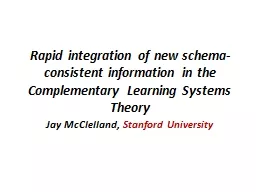

Jay McClelland Stanford University Complementary Learning Systems Theory McClelland et al 1995 Marr 1971 color form motion action valance Temporal pole name Medial Temporal Lobe ID: 904625
Download The PPT/PDF document "Rapid integration of new schema-consiste..." is the property of its rightful owner. Permission is granted to download and print the materials on this web site for personal, non-commercial use only, and to display it on your personal computer provided you do not modify the materials and that you retain all copyright notices contained in the materials. By downloading content from our website, you accept the terms of this agreement.
Slide1
Rapid integration of new schema-consistent information in the Complementary Learning Systems Theory
Jay McClelland,
Stanford University
Slide2Complementary Learning Systems Theory
(McClelland et al 1995; Marr 1971)
color
form
motion
action
valance
Temporal
pole
name
Medial Temporal Lobe
Slide3Principles of CLS TheoryHippocampus uses sparse, non-overlapping representations, minimizing interference among memories, allowing rapid learning of the particulars of individual memories
Neocortex uses dense, distributed representations, forcing experiences to overlap, promoting generalization, but requiring gradual, interleaved learning
Working together, these systems allow us to learn
both
Details of recent experiencesGeneralizations based on these experiences
Slide4A model of neocortical learning for gradual acquisition of knowledge about objects (Rogers & McClelland, 2004)
Relies on
d
istributed representations capturing aspects of meaning that emerge through a very gradual learning process
The progression of learning and the representations formed capture many aspects of cognitive developmentDifferentiation of concept representations
Generalization, illusory correlations and overgeneralizationDomain-specific variation in importance of feature dimensionsReorganization of conceptual knowledge
Slide5Slide6The Rumelhart Model
Slide7The Training Data:
All propositions true of
items at the bottom level
of the tree, e.g.:
Robin can {grow, move, fly}
Slide8Target output for ‘robin can’ input
Slide9a
j
a
i
w
ij
net
i
=
S
a
j
w
ij
w
ki
Forward Propagation of Activation
Slide10d
k
~ (t
k
-a
k
)
w
ij
d
i
~
S
d
k
w
ki
w
ki
a
j
Back Propagation of Error (
d)
Error-correcting learning:
At the output layer: Dwki =
ed
kai At the prior layer:
Dwij = edj
aj …
a
i
Slide11Slide12Slide13E
x
p
e
r
i
e
n
c
e
Early
Later
Later
Still
Slide14Adding New Information to the Neocortical Representation
Penguin is a bird
Penguin can swim, but cannot fly
Slide15Catastrophic Interference and Avoiding it with Interleaved Learning
Slide16Complementary Learning Systems Theory
(McClelland et al 1995; Marr 1971)
color
form
motion
action
valance
Temporal
pole
name
Medial Temporal Lobe
Slide17Tse et al (Science, 2007, 2011)
Slide18Slide19Schemata and Schema Consistent Information
What is a ‘schema’?
An organized knowledge structure into which new items could be added.
What is schema consistent information?
Information consistent with the existing schema.Possible examples:TroutCardinalWhat about a penguin?
Partially consistentPartially inconsistentWhat about previously unfamiliar odors paired with previously unvisited locations in a familiar environment?
Slide20New Simulations
Initial training with eight items and their properties as indicated at left.
Added one new input unit fully connected to representation layer to train network on one of:
penguin-
isa & penguin-cantrout-isa & trout-cancardinal-isa &
cardinal-canFeatures trainedcan grow-move-fly or grow-move-swimisa LT-animal-bird or LT-animal-fish
Used either focused or interleaved learningNetwork was not required to generate item-specific name outputs (no target for these units)
Slide21Slide22Slide23Slide24Slide25Slide26Simulation of Tse et al 2011
three old items (2 birds, 1 fish)
two old (1b 1f) and one new (f or b)
three new itemsxyzzy
isa LT_PL_FI / can GR_MV_SGyzxxz isa LT_AN__TR / can GR_____FLzxyyx isa LT_PL_FL / can GR_MV_SW
random items
Slide27Slide28What’s Happening Here?For XYZZX-type items:
Error signals cancel out either within or across patterns, causing less learning with inconsistent information.
For random-type items:
Signals may propagate weakly when features must be activated in inappropriate contexts
Slide29Is This Pattern Unique to the Rumelhart Network?
Competitive learning system trained with horizontal or vertical lines
Modified to include ‘conscience’ so each unit is used equally and so that weight change is proportional act(winner)^1.5
Learning
accellerates gradually til mastery then must start over.
Slide30Open Question(s)What are the critical conditions for fast schema-consistent learning?
In a back-prop net
In other kinds of networks
In humans and other animals